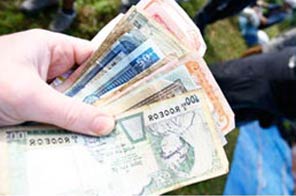Remittance up by 51 per cent
KATHMANDU: Remittance grew by 51 per cent in the first 11 months of the fiscal year 2008-09, said Nepal Rastra Bank (NRB). The central bank has estimated Rs 200 billion remittance by the end of the fiscal year 2008-09 in the Monetary Policy. It seems, the Monetary Policy’s target of Rs 200 billion remittance is going to come true.
“Under transfers, workers’ remittances soared by 51 per cent in comparison to the growth of 37.3 per cent in the corresponding period of the preceding year. Grants rose by 22.3 per cent in the review period in comparison to a growth of just 6.6 percent in the corresponding period of the preceding year,” according to the current Macroeconomic Situation based on the first eleven months’ data of 2008-09.
The overall Balance of Payment (BoP) posted a significant surplus of Rs. 39.06 billion in the first 11 months of 2008-09 in comparison to a lower surplus of Rs 24.67 billion in the corresponding period of the preceding year, said the report. “The current account recorded a double growth as it posted massive surplus of Rs 39.58 billion in the review period in comparison to a surplus of Rs 15.98 billion in the corresponding period the fiscal year before last. The significant current account surplus in the review period was largely attributed to the rise in net transfers by 38.5 per cent in the first 11 months of 2008-09.
In mid-June 2009, the gross foreign exchange reserves stood at Rs 271.68 billion, an increment of 27.8 per cent compared to the level as in mid-July 2008. Such reserves had risen by 25.2 per cent in the corresponding period of the preceding year. On the basis of the US dollar, the gross foreign exchange reserves went up by 15.8 per cent to $3.59 billion in mid-June 2009. Such reserves had risen by 18.6 percent in the same period of the previous year. The current level of reserves is adequate for financing merchandise imports of 11.8 months and merchandise and service imports of 9.6 months,” said the report.
During the review period, exports increased by 15.4 per cent in contrast to a decline by 2.1 per cent in the corresponding period the preceding year. Exports to India rose by 8.5 per cent in 2008-09 as against a decline of 8.2 per cent the preceding year. Exports to other countries expanded by 28.8 per cent compared to an increase of 12.3 per cent in the same period the preceding fiscal year.
The budget remained at a surplus of Rs 1.7 billion in contrast to a deficit of Rs 9.3 billion in the corresponding period the preceding year. An impressive growth in resource mobilisation relative to government expenditure accounted for such a budget surplus in the review period. The government has significant cash surplus of Rs 17.4 billion (including the Rs 3.9 billion of the preceding year) with Nepal Rastra Bank.
However, the government has failed to control the price hike as the price hike is still between 12 per cent to 12.3 per cent. “The year-on-year (y-o-y) inflation as calculated by the consumer price index rose to 12.3 per cent in Mid-June 2009 from 11 per cent in the same period of the preceding year,” said the report. Inflation, in the review period, was driven mainly by the rise of 19 per cent in food and beverages group. The price index of non-food and service group increased by only 5.1 per cent. The price rise of food and beverages and non-food and services group, was 13 per cent and nine per cent respectively, in Mid-June 2008. In the review period, the y-o-y core inflation rose to 12.6 percent from 8.3 percent a year ago.
No new licences
KATHMANDU: Nepal Rastra Bank (NRB) has decided to stop issuing licenses to new banks and financial institutions. According to an NRB Board meeting on Monday, the central bank will review the existing licensing policy and procedures. “NRB is not entertaining applications for new banks and financial institutions until it appraises the current situation and prepares a report on existing licensing policy,” a central bank press note read. However, banks and financial institutions that are in the pipeline will get the licence, the central bank clarified. “We will entertain the application for D-class micro-finance institutions,” the central bank said. Current NRB governor Bijaya Nath Bhattarai at the time of his reappointment had hinted at halting licences for new banks and financial institutions. According to him, the central bank wishes to have few but stronger banks rather than a huge number of banks and financial institutions.
Currently, there are 181 banks and financial institutions — 26 commercial banks, 63 development banks, 77 finance companies and 15 micro-finance development banks. — HNS






